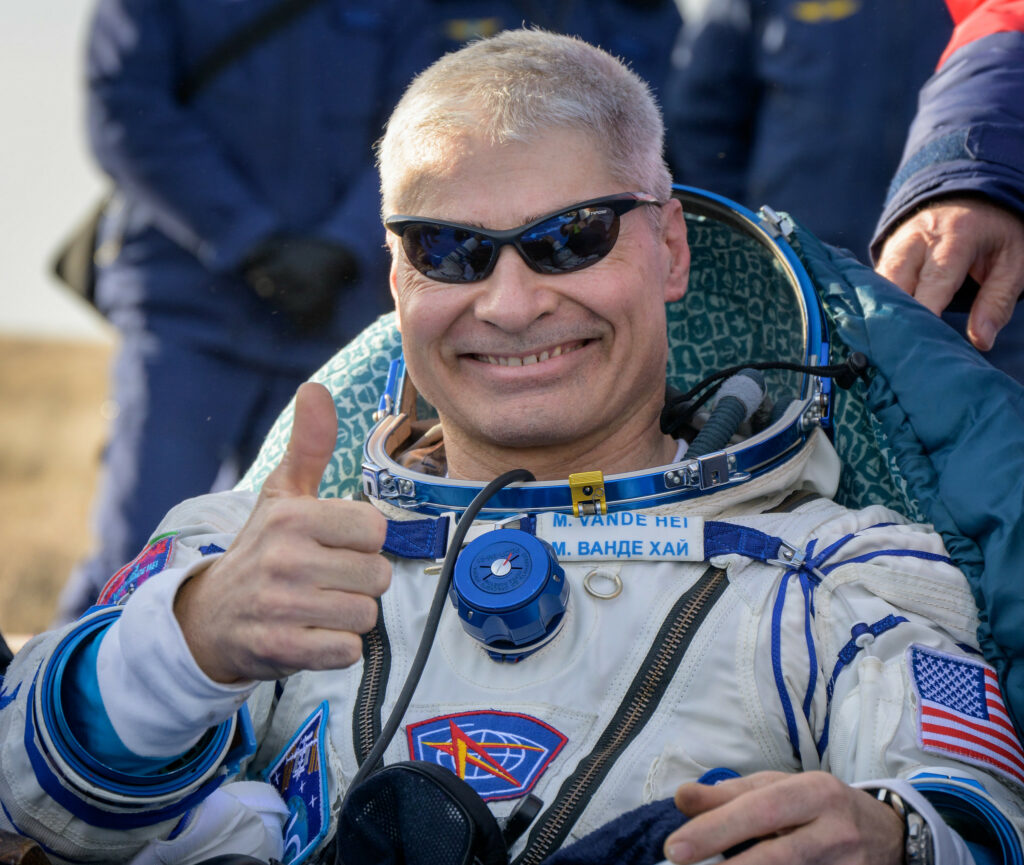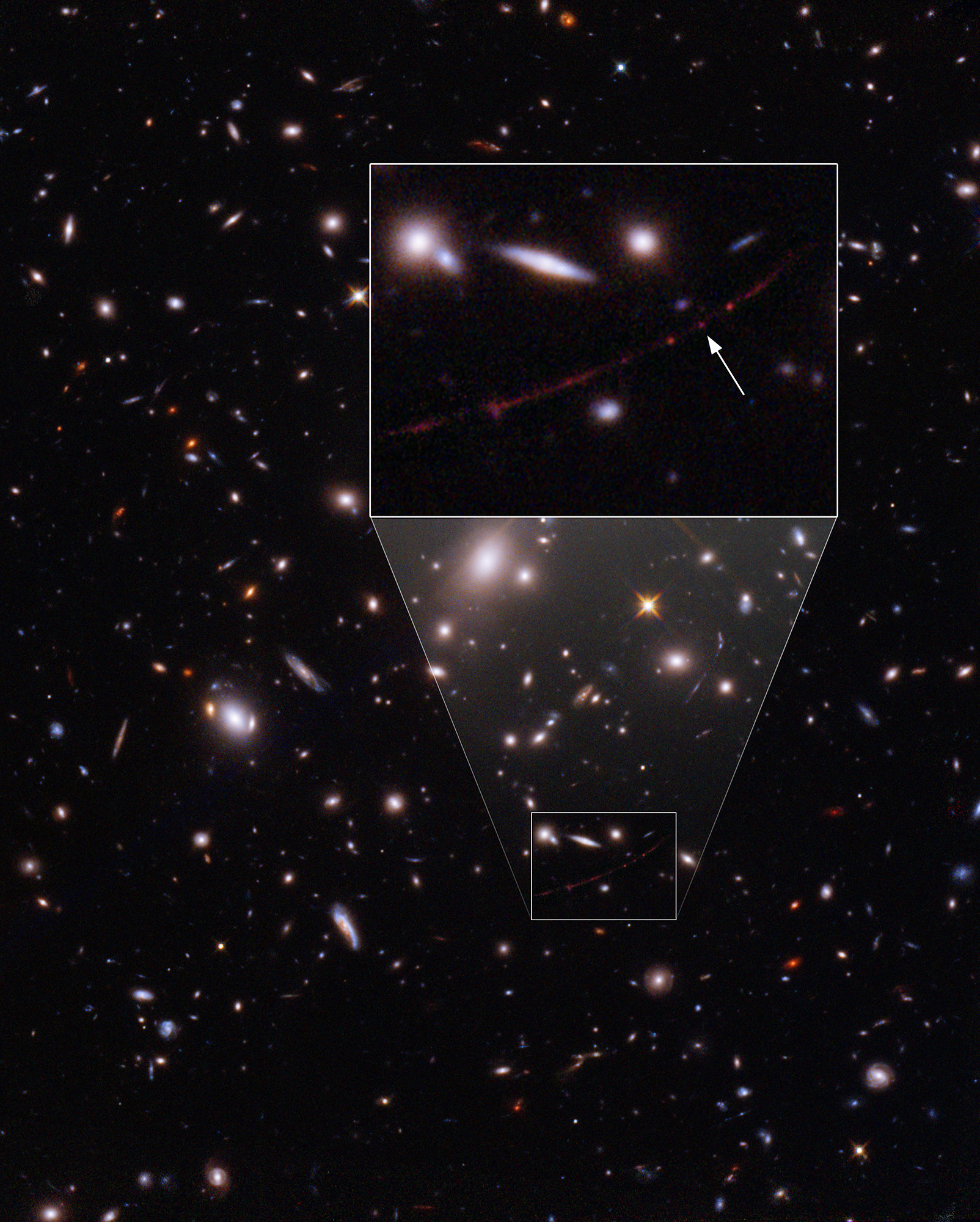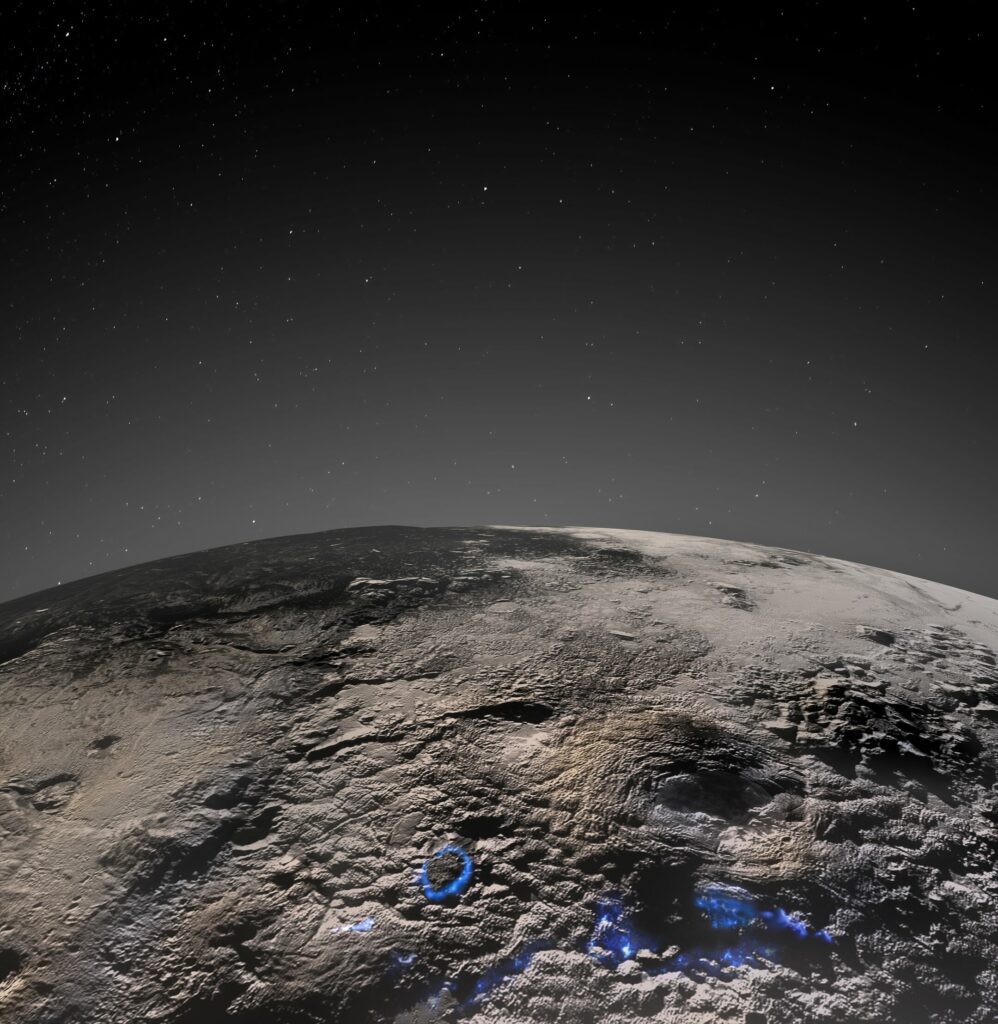Researchers pouring through high-resolution Hubble images of galaxy clusters have found the gravitationally magnified light of a star that was shining just four billion years after the Big Bang, making this bright star the new record holder for the farthest ever spotted. Plus, some launches, ice volcanoes on Pluto, melting Arctic ice, and this week in rocket history, we look back at INSAT.
Podcast
Show Notes
Record-breaking astronaut returns to Earth
- NASA press release
China launches three satellites on small rocket
Blue Origin launches fourth crewed mission
- Blue Origin press release
Hubble finds farthest star ever spotted
- ESA Hubble press release
- Hubblesite press release
- “A highly magnified star at redshift 6.2,” Brian Welch et al., 2022 March 30, Nature
Ice volcanoes on Pluto may be “recent”
- SwRI press release
- “Large-scale cryovolcanic resurfacing on Pluto,” Kelsi N. Singer et al., 2022 March 29, Nature Communications
Arctic aerosols affect cloud formation
- University of Michigan press release
- “Solid organic-coated ammonium sulfate particles at high relative humidity in the summertime Arctic atmosphere,” Rachel M. Kirpes et al., 2022 March 28, PNAS
Greenland Ice Sheet melting
- It’s Getting Hot Under Greenland (Eos)
- “Rapid basal melting of the Greenland Ice Sheet from surface meltwater drainage,” Tun Jan Young et al., 2022 February 22, PNAS
This Week in Rocket History: INSAT
- INSAT-2E info page (ISRO)
- INSAT-2 info page (eoPortal)
- What is a Cospas-Sarsat Beacon? (Cospas-Sarsat)
- INSAT-2E completes 13 years in orbit (First Post)
Transcript
Rockets are launching again, and we have some updates on a few today.
Plus, Hubble finds a star very, very far away.
And we look at ice volcanoes on Pluto, which are really neat.
As well as melting ice in the Arctic, which is not as neat.
And this week in rocket history, we get away from space shuttle missions to learn about some Indian Space Research Organization Earth-observing satellites from the 1990s.
All of this now, right here on the Daily Space.
I am your host Dr. Pamela Gay.
I am your host Erik Madaus.
And we’re here to put science in your brain.

As we mentioned last week, NASA astronaut Mark Vande Hei was going to return on the Soyuz MS-19 spacecraft back to Kazakhstan, and people were concerned due to the current tensions with regards to Russia. That has now occurred, and he is back safe at the Johnson Space Center in Houston, Texas, after 355 days in space.
On March 30 at 02:29 UTC, a Chinese Long March 11 rocket launched three satellites into orbit from the Jiuquan Satellite Launch Center in China. The three satellites – Tianping 2 A, B, and C – will be used for ground radar calibration and upper atmosphere research to model satellite orbits.
On March 31 at 13:57 UTC, a Blue Origin New Shepard suborbital rocket launched the NS-20 mission from their west Texas launch site to an apogee of 106 kilometers above ground level. This was the fourth crewed flight of the New Shepard.
Onboard were another six passengers, mostly the usual complement of business people, but also Gary Lai, the engineer responsible for the design and development of the New Shepard program as its Chief Architect. This makes him one of only a handful of people, most of whom are Russian, to fly into space in a spacecraft they designed.
From an astronaut who spent a long time in space, we now turn to light that took a long time on its journey to Earth.

Researchers pouring through high-resolution images of galaxy clusters have found the gravitationally magnified light of a star that was shining just four billion years after the Big Bang. While we’ve seen galaxies that are much further away, this bright star is the new record holder for the farthest star ever spotted. According to Brian Welch: We almost didn’t believe it at first, it was so much farther than the previous most distant, highest redshift star. Normally at these distances, entire galaxies look like small smudges, with the light from millions of stars blending together. The galaxy hosting this star has been magnified and distorted by gravitational lensing into a long crescent that we named the Sunrise Arc.
Welch is the first author of a newly published paper in the journal Nature.
To understand this discovery, I had to learn some cool new optics, and now, I am here to share all the awesomeness with you, so we can better understand this discovery together.
First, let’s consider the simple concept of “what is a lens.”
I have started wearing glasses and am experiencing the world-warping way progressive lenses bend the world. That, at a certain level, is the most basic definition of a lens — anything that bends light is a lens. Light can get bent as it goes through transparent-ish material like glass, plastic, or even water. It can also happen when light reflects off a surface, like with mirrors. And gravity can bend the path of light.
When a bunch of rays of light from a bunch of different places gets focused together, magnification can occur. This is the basic idea behind gravitational lenses: the gravity of massive systems, like galaxy clusters, can bend a bunch of light rays toward us — light that otherwise would have headed elsewhere in the universe. This added light allows us to see distant objects that would otherwise be far too faint for our current telescopes.
Since we can’t directly observe the earliest galaxies forming or see the first stars, researchers have been looking for the twisted light created through gravitational lensing. The Hubble Space Telescope even conducted a major survey – the RELICS or Reionization Lensing Cluster Survey – to look for these streaks, and it was in the RELICS data that our new star was found.

But it wasn’t just gravitationally lensed like any everyday lens might do; this star’s light fell in a sweet spot that allowed it to be magnified far more than we normally see. That sweet spot is called a caustic, and this is my new vocabulary word for the day.
When light passes through a cup of water or a wavy pool, it can get focused into a set of arcs that come together to create particularly bright points and ripples. These particularly bright areas are called caustics. They don’t teach you about these in your standard undergrad optics class because the math is more than your standard undergrad can handle. I’m glad I’m learning about them now and not then.
All that ugly math and beautiful physics allowed one star, at just the right point, to be amazingly magnified.
But even with this perfect alignment, your run-of-the-mill star wouldn’t have been visible. This star is special in so many ways. Named Earendal, which means “morning star” in old English, it is fifty times larger and millions of times brighter than our Sun. While it’s most likely not a star made of the original mix of hydrogen, helium, and trace amounts of lithium and beryllium created by the Big Bang, this star could be that kind of star.
And this tantalizing possibility makes Earendal and its host galaxy, the Sunrise galaxy, a prime target for JWST, when and if it works. Co-author Dan Coe states: With Webb, we expect to confirm Earendel is indeed a star, as well as to measure its brightness and temperature. We also expect to find the Sunrise Arc galaxy is lacking in heavy elements that form in subsequent generations of stars. This would suggest Earendel is a rare, massive metal-poor star.
There are truly beautiful things at the edge of space-time, and it is exciting to finally get to see them.
But there are also beautiful things closer to Earth, or at least closer on cosmic scales. Let’s swing back to our solar system and look at some volcanoes on Pluto.
Planetary science time!

A new analysis of images taken by the New Horizons spacecraft as it flew by Pluto back in 2015 has found that several giant ice volcanoes were active in the geologically recent past. These findings suggest that Pluto managed to hang on to its internal heat longer than previously thought, and that could change our perspective on other bodies in our solar system.
The results were published in Nature Communications and led by Kelsi Singer.
Ice volcanoes, as you probably expect, are different from the terrestrial lava-based volcanoes we have on Earth and other planets such as Venus and Mars. Instead of fountains of lava, ice volcanoes have a “thicker, slushy icy-water mix or even possibly a solid flow like glaciers,” according to Singer. And the ones on Pluto don’t match what we’ve seen on other icy worlds in our solar system. Singer goes on to explain: The features on Pluto are the only vast field of very large icy volcanoes and they have a unique texture of undulating terrain… we believe they could be as young as a few hundred million years or even younger.
Even more intriguing, the region is pretty clear of impact craters, so these eruptions could still be happening. And one of the possible cryovolcanoes, Wright Mons, is huge – five kilometers high and 150 kilometers wide, with the same volume as Mauna Loa in Hawai’i.
I think Singer summed up the discovery best when she said: I love the idea that we have so much left to learn about the solar system. Every time we go somewhere new, we find new things that we didn’t predict—like giant, recently-formed ice volcanoes on Pluto.
We love the idea, too, and we look forward to more stories like this as we continue to gain insight into our own solar system.
And now for a couple of stories that just, well, aren’t as fun.

Also in the summer of 2015, samples were collected from the Arctic atmosphere that contained aerosols – particles suspended in the atmosphere that aren’t a part of the natural composition. Think of it like particles suspended in a liquid, but instead of solids in a liquid, aerosols are liquids suspended in a gas.
Now, in a new paper published in the Proceedings of the National Academy of Sciences, then-doctoral student Rachel Kirpes analyzed those aerosols and discovered that the ammonium sulfate particles weren’t liquid – they were solid. This is not a good thing. Solid aerosols change how clouds form. Combined with the ongoing loss of Arctic sea ice, which results in more open water and more aerosols released from the ocean, we end up with a warmer atmosphere and more clouds.
So why do we expect liquid aerosols and how did we end up with solid ones instead? We expect them because the humidity over any ocean is pretty high, more than 80% as we have a constant exchange of water into water vapor. Generally, the aerosols stay liquid until the humidity drops below about 40%, which is unlikely to happen over the water. Further, co-author Andrew Ault explains: …what we saw is a pretty new phenomenon where a small particle collides with our droplets when it’s below 80% humidity, but above 40% humidity. Essentially, this provides a surface for the aerosol to solidify and become a solid at a higher relative humidity than you would have expected. These particles were much more like a marble than a droplet. That’s really important, particularly in a region where there haven’t been a lot of measurements because those particles can eventually end up acting as the seeds of clouds or having reactions happen on them.
All this new information means we can add another factor to our climate models, which were already looking kind of grim.

In further news of Arctic climate awfulness, meltwater under the Greenland Ice Sheet is draining so much and so fast that it could power a “massive” hydroelectric power station. Yay?
We’ve established that climate change is real and Earth is warming. Greenland’s ancient ice is melting. In fact, it now rains at the highest point in Greenland, and the meltwater itself is adding a millimeter of water to the sea level every year. Just the meltwater from Greenland is doing that. Folks, this is not good.
So Poul Christoffersen and his team installed a radio-echo-sounding instrument about 30 kilometers inland at Store Glacier and then drilled a borehole next to the instrument. With the data they collected from both the instrument and the borehole itself, they were able to track the water that is underneath the ice sheet and understand how it interacts with the ice. The results were also published in the Proceedings of the National Academy of Sciences.
The average melt rate was 14 millimeters per day with one extreme event that happened during a rainfall, which led to 57 millimeters of melt. Per Christoffersen: 82 million cubic meters of water were delivered to the base of this glacier in a single day.
Back to that hydroelectric power station comment. All that energy produced actually adds to the melt rate. Rather than just forming small channels as the water flows, the water spread out and heated a larger area of the subsurface ice. And it’s a snowball type of process that gets bigger and bigger in a feedback loop – more flowing water means higher temperatures means more melt and so on. As Christofferses notes: It’s a super-powerful mechanism that’s going to alter the thermal state of the interior of the ice sheet as we get meltwater at higher and higher elevations.
Keep in mind that this research was done using a single radar instrument and is only applicable to Greenland and its subglacial drainage regions, not the ice sheet as a whole. That doesn’t make the news better, but it does keep it in perspective. More work is needed to understand how the meltwater affects the entirety of the ice sheet. Perhaps an array of these sensors? We will, of course, bring you updates on all things climate change here on Daily Space.
Finally, let’s move on to this week in rocket history those Earth-observing satellites from ISRO.
This Week in Rocket History

Why have a satellite with just one mission when it can have three! That was the conclusion of the Indian Space Research Organization (ISRO) in the 1970s when they designed the Indian National Satellite, or INSAT, series of satellites with a combination of Earth observation, communication, and television broadcasting functions from geostationary orbit. The first series of satellites, four in total, were built and launched by the U.S., though they were designed with a lot of Indian input. Two of them, INSAT-1A and -1C, were lost within a year of launch, while INSAT-1D worked for twelve years.
The second generation, the subject of today’s This Week In Rocket History, were all launched on Ariane 4 rockets but designed and built in India by ISRO. INSAT-2E, the fourth and last of this second generation, was launched on April 2, 1999, aboard an Ariane 4 from ELA-2 at the Guiana Space Centre in French Guiana. At launch, it weighed a hair over 2.5 metric tons, burning just over half of that to raise itself into geostationary orbit.
INSAT-2E had two scientific instruments – a Very High-Resolution Radiometer (VHRR) and a CCD camera. The VHRR operated in several spectral bands — visible and thermal infrared. It also operated in several modes, one of which could scan the entire Earth plus some area around it in a half-hour, between 50 degrees north and 40 degrees south, in 23 minutes, and anywhere along a north-south line in just over seven minutes. The CCD camera worked in visible, near-infrared, and short infrared bands with a one-kilometer resolution.

In addition, it had a Satellite Search and Rescue beacon and a Data Collection System used to relay data from different weather stations around the country to a central location for analysis. The Cospas-Sarsat system is an international system of about fifty satellites that provides search and rescue beacon detection anywhere on Earth with distress alerts detected, located, and forwarded to over 200 countries that participate in the program, at no cost to the beacon owners or the receiving government agencies. There are different types of beacons for people, ships, and planes, all of which operate on a frequency of 406 megahertz. The different beacons can also be activated in different ways, from shock to immersion in water, to the user pressing a button.
INSAT 2E’s communications payload had seventeen C-band transponders, powered by a single solar panel providing 2.5 kilowatts of power. Although the scientific instrument, the VHRR, failed in 1999, the satellite continued to work for the remainder of its thirteen years of operation as a communications satellite, along with the camera, before being turned off in 2012.
The failed VHRR on INSAT-2E was replaced in 2002 by a new satellite, METSAT, which was later renamed Kalpana-1 after the Indian-born American astronaut Dr. Kalpana Chawla who lost her life in the Columbia disaster in 2003. METSAT/Kalpana-1 was also the first Indian satellite launched to geostationary orbit on an Indian rocket, a PSLV. The PSLV was the first Indian rocket capable of putting a large payload into a geostationary transfer orbit.
Statistics
And now, for some statistics.
The number of toilets in space is eight: four on the ISS, one on the Soyuz, one on the Crew Dragon, one on Shenzhou 13, and one on Tianhe.

We keep track of orbital launches by launch site, also called spaceport. Here’s that breakdown:
USA 18
China 7
Kazakhstan 3
Russia 2
India 1
Iran 1
New Zealand 1
From those 33 launches, a total of 592 spacecraft were put into orbit.
Your random space fact for this week is that in 2013, engineering students at Rice University designed a new system for brewing coffee in space. They called themselves “Houston We Have Coffee”. The system has bags and hoses that also allow for freeze-dried cream and sugar to be added to the hot water.
This has been the Daily Space.
You can find more information on all our stories, including images, at DailySpace.org. As always, we’re here thanks to the donations of people like you. If you like our content, please consider joining our Patreon at Patreon.com/CosmoQuestX.
Credits
Written by Pamela Gay, Beth Johnson, Erik Madaus, and Gordon Dewis
Hosted by Pamela Gay, Beth Johnson, and Erik Madaus
Audio and Video Editing by Ally Pelphrey
Content Editing by Beth Johnson
Intro and Outro music by Kevin MacLeod, https://incompetech.com/music/


 We record most shows live, on Twitch. Follow us today to get alerts when we go live.
We record most shows live, on Twitch. Follow us today to get alerts when we go live.